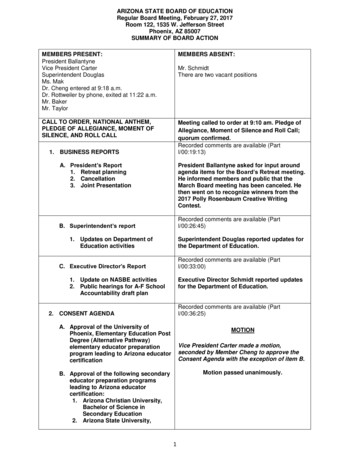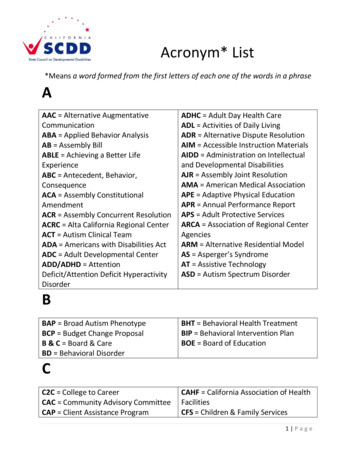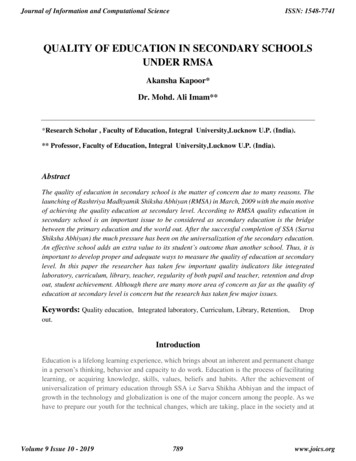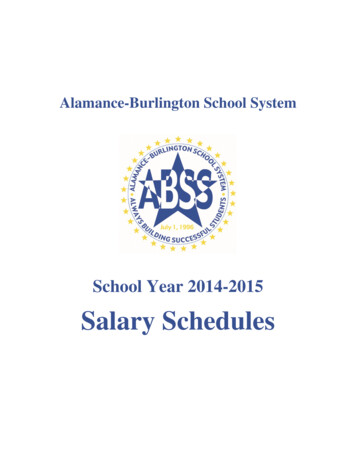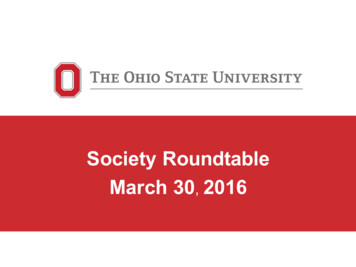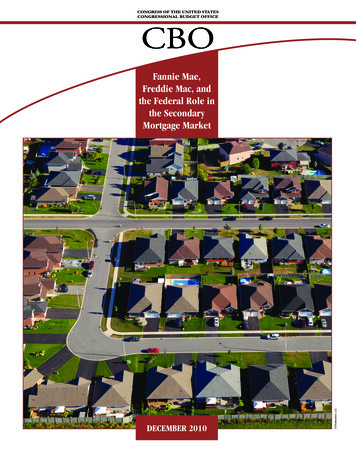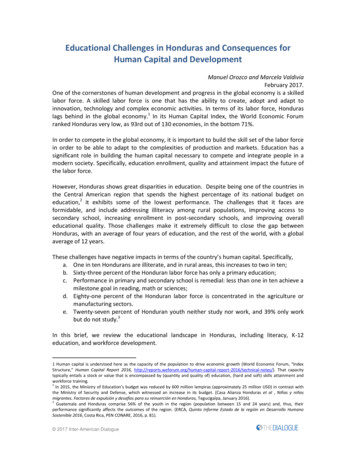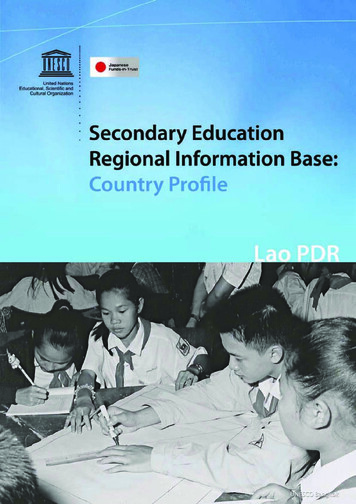
Transcription
Secondary education regional information base: country profile –Lao PDR. Bangkok: UNESCO Bangkok, 2008.23 pp.1. Secondary education. 2. Educational Policy. 3. Lao PDR.ISBN 978-92-9223-172-9 (Print version)ISBN 978-92-9223-173-6 (Electronic version)Chief Editor:Editor:Design/Layout:Cover photo:Caroline HaddadTakayo Ogisu and Yoko SatoPongsuda Vongsingha Inthasone Phetsiriseng UNESCO 2008Published by theUNESCO Asia and Pacific Regional Bureau for Education920 Sukhumvit Road, PrakanongBangkok 10110. ThailandPrinted in ThailandThe designations employed and the presentation of material throughout the publicationdo not imply the expression of any opinion whatsoever on the part of UNESCO concerningthe legal status of any country, territory, city or area or of its authorities, or concerning itsfrontiers or boundaries.EPR/08/EP/026-1
Table of ContentsList of Tables and FiguresAcknowledgementReader’s GuideAbbreviations1 Secondary Education at a Glance1.11.21.31.41.51.6Education System. . . . . . . . . . . . . . . . . . . . . . .Size of Schooling Sector. . . . . . . . . . . . . . . . . . . .Access and Participation . . . . . . . . . . . . . . . . . . . .Geographical Distribution of Access. . . . . . . . . . . . . .Student Progression . . . . . . . . . . . . . . . . . . . . . .PTR and Average Class Size. . . . . . . . . . . . . . . . . . .1123442 Institutional Context of Secondary Education2.12.22.32.4Education System. . . . . . . . . . . . . . . . . . . . . . .Legislative Framework and Key Policy Documents. . . . . . . .Administrative Structure. . . . . . . . . . . . . . . . . . . .Financing. . . . . . . . . . . . . . . . . . . . . . . . . . .55783 General Secondary Education3.13.23.33.43.5Types of Schools . . . . . . . . . . . . . . . . . . . . . . . 11Admission Requirements. . . . . . . . . . . . . . . . . . . 11Student Assessment and Promotion . . . . . . . . . . . . . .12Tuition . . . . . . . . . . . . . . . . . . . . . . . . . . . . 13Curriculum . . . . . . . . . . . . . . . . . . . . . . . . . . 144 Private Education. . . . . . . . . . . . . . . . . . . . . . . . . 155 Secondary Level Technical and Vocational Education. . . . . . . .156 Teachers in General Secondary Education6.16.26.3Teacher Management. . . . . . . . . . . . . . . . . . . . . 17Qualifications and Pre-service Training. . . . . . . . . . . . . 17In-service Training . . . . . . . . . . . . . . . . . . . . . . 177 Recent Reforms. . . . . . . . . . . . . . . . . . . . . . . . . . 198 Involvement of Development Agencies . . . . . . . . . . . . . . 209 Relevant Documents and Additional Resources . . . . . . . . . . 21Reference. . . . . . . . . . . . . . . . . . . . . . . . . . . . . . . 22Annex: Background Statistics: Development Indicators. . . . . . . . . 23
List of Tables and FiguresTable 1.School-aged Population, 2006. . . . . . . . . . . . . . . . . . . . . . . . . . . . . . . 1Table 2.Enrolment, 2005. . . . . . . . . . . . . . . . . . . . . . . . . . . . . . . . . . . . . . 1Table 3.Number of Teaching Staff (full and part-time), 2005 . . . . . . . . . . . . . . . . . . . . . 1Table 4.GER in Secondary Education, 2005. . . . . . . . . . . . . . . . . . . . . . . . . . . . . 2Table 5.NER in Secondary Education, 2005. . . . . . . . . . . . . . . . . . . . . . . . . . . . . 2Table 6.GER by Province and Sex, 2005/06 . . . . . . . . . . . . . . . . . . . . . . . . . . . . . 3Table 7.Progression Indicators, 2005. . . . . . . . . . . . . . . . . . . . . . . . . . . . . . . . 4Table 8.Pupil-teacher Ratio, 2005. . . . . . . . . . . . . . . . . . . . . . . . . . . . . . . . . 4Table 9.Average Class Size, 2005/06. . . . . . . . . . . . . . . . . . . . . . . . . . . . . . . . 4Table 10.Secondary Education Management by Office/Department. . . . . . . . . . . . . . . . . 8Table 11.Public Expenditure on Education, 2006/07. . . . . . . . . . . . . . . . . . . . . . . . . 9Table 12.Types of Secondary Schools, Administrative Authority, and Enrolments, 2006 . . . . . . . .11Table 13.Number of Institutions by Levels of Education, 2006. . . . . . . . . . . . . . . . . . . . 11Table 14.Percent of Repeaters by Grade and Sex, 2005 . . . . . . . . . . . . . . . . . . . . . . . 12Table 15.Statutory School-opening and Teaching Weeks per Year, Teaching Hours per Week. . . . . 14Table 16.Percent of Enrolment in Private Institutions, 2000 and 2005. . . . . . . . . . . . . . . . 15Table 17.Percent of Enrolment in TVE Programmes, 2000-2005 . . . . . . . . . . . . . . . . . . . 15Table 18.Number of Teachers and Key Indicators, 2005. . . . . . . . . . . . . . . . . . . . . . . 17Figure 1.Education Structure: Approximate Starting Age and Duration . . . . . . . . . . . . . . . . 1Figure 2.Change in Number of Enrolment, 1980-2005 . . . . . . . . . . . . . . . . . . . . . . . . 2Figure 3.Change in Number of Teaching Staff, 1980-2005 . . . . . . . . . . . . . . . . . . . . . . 2Figure 4.Change in GER by Level, 1970-2005. . . . . . . . . . . . . . . . . . . . . . . . . . . . 2Figure 5.GER by Province, 2005/06. . . . . . . . . . . . . . . . . . . . . . . . . . . . . . . . . 5Figure 6.MOE’s Organization Chart. . . . . . . . . . . . . . . . . . . . . . . . . . . . . . . . . 7Figure 7.Resource Allocation by Level as % of Total Education Expenditure, 1995-2005. . . . . . . . 9Figure 8.Resource Allocation by Nature of Spending as % of Total Education Expenditure, 2004/05. .10Figure 9.Educational Expenditure by Nature of Spending and Source, 2004/05. . . . . . . . . . . 10Figure 10. Transition Rate from Primary to Lower Secondary Education by Poverty Level,2001/02-2004/05. . . . . . . . . . . . . . . . . . . . . . . . . . . . . . . . . . . . . 12Figure 11. Transition Rate from Lower to Upper Secondary Education by Poverty Level,2001/02-2004/05. . . . . . . . . . . . . . . . . . . . . . . . . . . . . . . . . . . . . 13Figure 12. Enrolment by Types of TVE Institutions and Sex, 2005/06. . . . . . . . . . . . . . . . . .16Figure 13. Distribution of Secondary Teachers by Qualifications, 2005/06 . . . . . . . . . . . . . . . 18
AcknowledgementThis Lao PDR Country Profile has particularly benefited frominputs provided by consultants Mr. Claude Tibi and Mr. InthasonePhetsiriseng. The most recent data/information included within thisreport has been collected thanks to the collaboration of relevantoffices/departments at the Lao PDR Government’s Ministry ofEducation.This publication is part of a series of Secondary Education RegionalInformation Base Country Profiles developed by the EducationPolicy and Reform (EPR) Unit in collaboration with the Assessment,Information Systems, Monitoring and Statistics (AIMS) Unit andother relevant UNESCO Field Offices.The project receives a generous financial contribution from theJapanese Government.
Reader’s GuideThe following symbols are used in the statistical tables: No data availablenaNot applicable*National estimation**UIS estimation-Magnitude nil or negligible nData refers to the school or financial year (or period) after the reference year (or period)-nData refers to the school or financial year (or period) before the reference year (or period)General Notes:The Secondary Education Information Base: Country Profile uses statistics from the UNESCO Institute forStatistics (UIS) and national sources. Although, in principle, UIS statistics are used as the primary data sourceto facilitate comparison with other countries, nationally available statistics are used extensively where specificdata is not available from UIS.All data indicated as UIS data was retrieved from the UIS Education Database (http://www.uis.unesco.org)on January 30, 2008. Statistics from national sources were collected through questionnaires, and the originalsources are indicated under each table/figure.All tables and figures have been compiled by UNESCO Bangkok.Definitions:A comprehensive list of education indicators, including their definition, purpose, calculation method, andformulas used in their calculation, is available from the UIS Glossary of Education Indicators.Levels of education in UIS statistics are defined according to the International Standard Classification ofEducation (ISCED97).The year cited in tables and figures refers to the year in which the academic or financial year ends. Therefore,wherever the given year is spread across two calendar years, the year is cited according to the later year (e.g.academic year 2003/04 is presented as 2004). As for the statistics retrieved from national sources, the referenceyear is reserved as presented in the original source.
AbbreviationsADBAsian Development BankAPELAccreditation of Prior Experiential LearningBEGPBasic Education Girls ProjectCPICommittee for Planning and InvestmentDEBDistrict Education BureauDGEDepartment of General EducationDOFDepartment of FinanceDOPDepartment of PersonnelDRSData-base Reporting SystemDTEDepartment of Teacher EducationEFAEducation for AllEFA NPAEducation for All National Plan of ActionESITCEducation Statistics and Information Technology CenterGERGross Enrolment RatioGPIGender Parity IndexIBEInternational Bureau of EducationJICAJapan International Cooperation AgencyLAKLao Kip (currency)MOEMinistry of EducationNPANational Plan of ActionMOFMinistry of FinanceNGPESNational Growth and Poverty Eradication StrategyNSEDPNational Socio-economic Development PlanPDRPeople’s Democratic RepublicPESProvincial Education ServicePPPPurchasing Power ParityPTRPupil-teacher RatioQAQuality AssuranceRIESResearch Institute for the Educational ScienceSIDASwedish International Development Cooperation AgencyTATechnical AssistanceTESAPTeacher Education Strategy and Action PlanTTCTeacher Training CollegeTTSTeacher Training SchoolTVETechnical and Vocational EducationUISUNESCO Institute for StatisticsUNESCOUnited Nations Educational, Scientific, and Cultural OrganizationUSDUnited States Dollar (currency)
Lao PDR1 Secondary Education at a Glance1.1 Education SystemFigure 1. Education Structure: Approximate Starting Age and Duration1.2 Size of Schooling SectorTable 1. School-aged Population, 2006Table 2. Enrolment, 2005School-agedpopulationAve. Annual GrowthRate, Lower secondary469,9772.31%Upper secondary439,8983.62%Source: UNESCO Institute for Statistics. 2008a.EnrolmentAve. Annual GrowthRate, ower secondary243,7575.66%Upper secondary150,09912.36%Source: UNESCO Institute for Statistics. 2008a.Table 3. Number of Teaching Staff (full and part-time), 2005Number ofteaching staffAve. Annual GrowthRate, er secondary10,580**4.38%Upper secondary5,311**6.17%Source: UNESCO Institute for Statistics. 2008a.Note: Average annual growth rate was calculated by UNESCO Bangkok on the basis of UIS statistics.Lao PDR1
Figure 2. Change in Number of Enrolment,1980-2005Source: ESITC. 2007.Figure 3. Change in Number of Teaching Staff,1980-2005Source: ESITC. 2007.1.3 Access and ParticipationFigure 4. Change in GER by Level, 1970-2005Source: UNESCO Institute for Statistics. 2008a.Table 4. GER in Secondary Education, 2005TotalMaleFemaleGPI46.7%52.9%40.4%0.76Lower secondary56.2%62.5%49.6%0.79Upper secondary36.7%42.6%30.6%0.72SecondarySource: UNESCO Institute for Statistics. 2008a.Table 5. NER in Secondary Education, Source: UNESCO Institute for Statistics. 2008a.2Secondary Education Regional Information Base: Country Profile
1.4 Geographical Distribution of AccessFigure 5. GER by Province, 2005/06Source: ESITC. 2007.Table 6. GER by Province and Sex, 2005/06Lower SecondaryUpper SecondaryMaleFemaleGPIMaleFemaleGPIVientiane ang61.1%71.4%0.8637.8%47.3%0.80Vientiane 9.0%0.71Attapeu34.7%45.4%0.7619.4%31.7%0.61Note: Gender Parity Index (GPI) was calculated by UNESCO Bangkok on the basis of ESITC.Source: ESITC. 2007.Lao PDR3
1.5 Student ProgressionTable 7. Progression Indicators, 2005Gross Primary Graduation Ratio68.0%-1Transition rate from Primary to Secondary78.0%-1Gross Enrolment Ratio in Total Secondary44.1%Percentage of Repeaters in Total Secondary2.7%Upper Secondary Gross Graduation Ratio (General) Upper Secondary Gross Graduation Ratio (TVE) Source: UNESCO Institute for Statistics. 2008a.1.6 PTR and Average Class SizeTable 8. Pupil-teacher Ratio, 2005Lower secondary23.0Upper secondary28.3Source: UNESCO Institute for Statistics. 2008a.Table 9. Average Class Size, 2005/06Lower secondaryUpper secondaryGrade 647.8Grade 954.0Grade 745.1Grade 1053.4Grade 843.7Grade 1152.7LS total45.7Source: ESITC. 20074Secondary Education Regional Information Base: Country ProfileUS total53.4
2 Institutional Context of Secondary Education2.1 Education SystemFormal education in Lao People’s Democratic Republic (PDR) consists of primary education (five years),secondary education (six years), post-secondary education (one or two years), and tertiary education (threeto seven years).The level of education after primary education, referred to as secondary education, caters to children andadolescents who range in age from 11-16 years old, and it is divided into two stages: lower secondary educationand upper secondary education. Lower secondary education caters to 11- to 13-year-olds (Grade 6-8), whereasupper secondary education to 14- to 16-year-olds (Grade 9-11). This 3-3 system in secondary education hasbeen in the reform process since 2007 under the National Education System Reform Strategy (NESRS). Afterthe completion of the reform, lower secondary education will be extended to four years, catering to 11- to14-year-olds. Upper secondary education is further divided into two streams, namely, general education andvocational education (which includes teacher training).The Education Law issued in 2000 stipulates that all levels of education should be provided free of chargeto all children. Article 3 in particular has a statement on free secondary schooling and Article 4 on technicalvocational education (TVE). The country’s Education for All National Plan of Action (2004) has a target to expandthe definition of basic education up to lower secondary education by 2015.(See Figure 1. Education Structure: Approximate Starting Age and Duration on page 1.)2.2 Legislative Framework and Key Policy DocumentsA number of reports regarding the logical framework of the education system and policy suggestions havebeen prepared. The policy documents and reports that are currently in effect are presented below.The Resolution of the Fifth Party Congress, 1991-1996 (1991)The Resolution of the Fifth Party Congress sets the following seven goals on education: (a) to enforce compulsoryeducation for children and youth, using mainly state funds; (b) to eradicate illiteracy; (c) promote privateeducation in both general and vocational areas; (d) to reorganize secondary and vocational education in theprovinces to meet the needs of the country; (e) to raise the quality of education to international standards; (f )to expand education to reach the remote, isolated, and mountainous areas and build ethnic boarding schools;and (g) to improve the system of monks’ education and outline its policies.The Lao PDR Constitution (1996)Article 19 of the Lao PDR Constitution states that “Education, culture and scientific activities are the means toraise the level of knowledge, patriotism, love of the people’s democracy, the spirit of solidarity between ethnicgroups and the spirit of independence. The pursuit of compulsory education is important. The state permitsprivate schools that follow the state curriculum.”The Education Law (2000)The Education Law, issued in April 2000, stipulates that all Lao citizens have the right to education withoutdiscrimination based on their ethnicity, origin, religion, gender, or social status. In regards to secondaryeducation, the Education Law also establishes that “the government has the duty to expand secondaryeducation as appropriate for creating conditions for the development of Lao citizens’ necessary knowledge andcapacity for their occupation or further study”; “the government carefully plans the expansion of vocationaleducation according to the needs of the labor market and individual occupation”; and “the development ofvocational education has to get support and contribution from all concerned sectors of the government andthe involvement of state-owned and private enterprises.”11Lao People’s Democratic Republic. 2000. Education Law, p. 3.Lao PDR5
The Education Law, amended in 2006/07, states that all individuals and organizations have obligation to investand contribute to education and stipulates the introduction of 4-year lower secondary education system.The Educational Strategic Planning by 2010 and 2020 (2001)The Educational Strategic Planning by 2010 and 2020 recognizes the need for lifelong educational opportunitiesand considers education as a core component in overall human resource development. Based on the StrategicPlanning, a five-year education development plan is developed every five years.(See description on the Sixth Five-Year Plan of Educational Development 2006-2010 below.)The Education For All National Plan of Action, 2003-2015 (2004)The Education for All National Plan of Action (EFA NPA) recognizes EFA as the key plank of the Government’seducation strategy. In addition to primary education, the EFA NPA is meant to promote lower secondary,non-formal, and adult education. The three principles of increased equitable access, improved quality andrelevance, and stengthened decentralized management provide the framework for achiving EFA. The EFA NPArecommends that an increased share of the government budget goes toward eduation in order to improve thebalance between the investment and recurrent budget, and to significantly increase teachers’ salaries.The EFA NPA Programme 3, which calls for increasing access to and participation in lower secondary education,identifies the following priority goals: 1) achieving parity between girls and boys in access to lower secondaryeducation, particularly among ethnic groups and the poorest areas; and 2) reaching a national transition ratefrom Grade 5 to Grade 6 of 82.5 percent in 2010/11, and 85 percent in 2015/16. In addition to these two prioritygoals, EFA NPA sets quantitative targets in terms of number of enrolments, number of teachers to be recruited,and number of classrooms to be constructed.Most importantly, EFA NPA states that the general education system should be reformed to a 12-year systemby adding one additional year to the lower secondary education, i.e. 5 4 3, in order to lead to better growth,meet international standards, and contribute to the socio-economic development of the country.(See 7 Recent Reforms on page 19 to get more detailed information about the educational reform.)The Sixth Five-Year National Socio-Economic Development Plan, 2006-2010 (2006)The current National Socio-Economic Development Plan (NSEDP) sees education as a crucial priority area andone of the four pillars of the country’s poverty reduction strategy. The NSEDP emphasizes the development ofquality human resources in order to meet the nation’s socio-economic development needs. The measures toachieve education objectives include universalizing compulsory education at the primary level and increasingparticipation at the lower secondary level, “ensuring that all people have the opportunity to apply theireducation to serve the socio-economic development programme.”2The Sixth Five-Year Plan of Educational Development, 2006-2010 (2006)The Sixth Five-Year Plan of Educational Development shows the directions of educational development in LaoPDR during 2006-2010, specifically in regard to access, quality, and administration and management.In terms of development in secondary education, the plan focuses on expanding access to lower secondaryeducation as one of the major targets. It aims to improve the enrolment ratio during 2005-2010 from 54.4-68.4percent for lower secondary, and from 34.2-40.2 percent for upper secondary education.General education structural reform as described in the EFA NPA is also outlined in this plan.26Lao People’s Democratic Republic. 2006. National Socio-economic Development Plan (2006-2010), p. 145.Secondary Education Regional Information Base: Country Profile
2.3 Administrative StructureThe education system in Lao PDR is managed by the Ministry of Education (MOE) in association with theattached departments and institutions/agencies. The MOE takes management responsibility for the followingareas: (i) planning, (ii) budgeting and financing, (iii) personnel and human resources, (iv) academic affairs, and(v) properties and procurement (including school construction).The Department of General Education, attached to MOE, takes responsibility for administration on preschool, primary and secondary education, education for ethnic groups, French/Lao bilingual education, basiceducation for girls, and EFA-related matters. Technical and vocational education and private education areunder the administration of the Department of Higher, Technical & Vocational Education and the Departmentof Private Education, respectively.Figure 6. MOE’s Organization ChartLao PDR7
Lao PDR is in the process of decentralization across all sectors involved in socio-economic development, andthe Deconcentration Decree issued by the Prime Minister Office in March 2000 outlines the specific roles andresponsibilities played by provinces, districts, and villages as follows: the province acts as the strategic unit fordevelopment, capable of supervising and leading managment in all areas; the district acts as a planning andbudgeting unit, with responsibility for the preparation of plans and projects, and monitoring and evaluationof their implementation; and the village acts as a basic implementation unit. In the context of the Educationsector, MOE shares its responsibilities with Provincial Education Services (PES) and the Distict EducationBureaus (DBE). Each PES is responsible for (1) secondary level institutions and (2) vocational institutions thatare delegated by the MOE. Each DEB takes responsibility for pre-school, primary and non-formal educationinstitutions within its own district.In addition to the roles and responsibilities of MOE, PES, and DEB, communities often take initiative in supportof primary and secondary education. In some cases, this initiative extends to construction and maintenance ofschool facilities, employment of teachers, and part of payment for salaries to teachers who are contracted bycommunities.The following offices/departments are responsible for different functions of secondary education management:Table 10. Secondary Education Management by Office/DepartmentFunctionsResponsible bodyGeneral secondary educationDepartment of General Education, MOETVE at the secondary levelDepartment of Higher, Technical and Vocational Education, MOESecondary teacher in-service trainingDepartment of Teacher Education, MOEPersonnel management and developmentDepartment of Personnel, MOECurriculum development and researchResearch Institute for Educational ScienceLearning assessmentResearch Institute for Educational ScienceBudgetingDepartment of Finance, MOEProvincial Education ServicesMinistry of FinanceCommittee for Planning and InvestmentPlanningDepartment of Planning and Co-operation, MOECommittee for Planning and InvestmentPrivate educationDepartment of Private Education, MOENon-formal educationDepartment of Non Formal Education, MOEEMISEducational Statistics and Information Technology Centre, MOETestingDepartment of General Education, MOELearning/teaching materials and equipmentResearch Institute for Educational Science2.4 FinancingThe resource management mechanism in Lao PDR is undergoing a process of decentralization. Overall, therecurrent budget is funded out of domestic resources from the Ministry of Finance (MOF), and the investmentbudget is to a large extent funded by external resources and managed by the Committee for Planning andInvestment (CPI) with MOF’s involvement.The formal budget preparation process takes place within the framework of decentralized planning andinvolves both central ministries and provincial governments. There is both a “bottom up” and a “top down”process. Budget requests move from schools to the district (DEBs) and from the district to the provincialgovernments (PESs). PESs submit their budget requests in the second quarter of the year, and they are finally8Secondary Education Regional Information Base: Country Profile
consolidated within MOE’s budget proposal to be submitted to MOF and CPI at the same time of the year. The“top down” phase starts with review by MOF and CPI, followed by regional conferences mid-year to establishthe overall budget limits for each province, the shares for each sector, and recurrent and capital shares. After aseries of revisions and further negotiations the recurrent budget is finalized by MOF, and the capital budget byCPI. Both are submitted to the National Assembly during October-November.Fiscal year is October 1 – September 31.School year is September 1 – June 30.Table 11. Public Expenditure on Education, 2006/07As % of GDP(1)As % of total govt. expenditure(1)2.29%-211.71%-2Per pupil as % of GDP per capita(2)Pre-primary education1.23%Primary education38.19%Lower secondary8.37%Upper secondary5.30%Tertiary education24.90%Source: (1) UNESCO Institute for Statistics. 2008a. (2) DOF, MOE.Figure 7. Resource Allocation by Level as % of Total Education Expenditure, 1995-2005Source: CPI. 2006.Lao PDR9
Figure 8. Resource Allocation by Nature of Spending as % of Total Education Expenditure, 2004/05Source: CPI. 2006.Figure 9. Educational Expenditure by Nature of Spending and Source, 2004/05Source: CPI. 2006.10Secondary Education Regional Information Base: Country Profile
3 General Secondary Education (GSE)3.1 Types of SchoolsThere are three different types of institutions offering secondary education: lower secondary schools, uppersecondary schools, and complete secondary schools, which provide education at both lower and upper levels.All institutions offering general secondary education are under the authority of the Ministry of Education.Table 12. Types of Secondary Schools, Administrative Authority, and Enrolments, 2006GradeAdministrativeauthorityNumber ofInstitutionsEnrolmentsLower secondaryDEB642126,573Upper secondaryPES2827,222Complete secondary (LS US)PES310238,09067891011LS Lower secondary; US Upper secondarySource: ESITC. 2006.Table 13. Number of Institutions by Levels of Education, cational & Technical51Teacher Training14TertiaryTotal310,787Source: MOE. 2006a.3.2 Admission RequirementsThe transition system in Lao PDR is based on the results of a school-leaving examination. Admission in Grade6 (the first year of lower secondary education) is open to all students having passed the Primary EducationAchievement Examination held at the end of Grade 5. Similarly, admission in Grade 9 (the first year of uppersecondary education) is open to all students having passed the Lower Secondary Achievement Examination,held at the end of Grade 8. However, the administration body for the examination varies between the twolevels. While DEBs are responsible for the administration of the examination in primary schools and admissionto lower secondary schools, PESs take responsibility for examination in lower secondary schools and admissionto upper secondary schools.Lao PDR11
Figure 10. Transition Rate from Primary to Lower Secondary Education by Poverty Level3,2001/02-2004/05Sourc
Lao PDR 1 Lao PDR 1 Secondary Education at a Glance 1.1 Education System Figure 1. Education Structure: Approximate Starting Age and Duration 1.2 Size of Schooling Sector Table 1. School-aged Population, 2006 School-aged population Ave. Annual Growth Rate, 2001-2006 Source: UNESCO Institute for Statistics. 2008a. Table 3.
